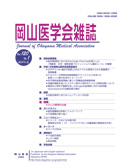

Journal of Okayama Medical Association
Published by Okayama Medical Association<Availability>
Full-text articles are available 3 years after publication.
Permalink : http://escholarship.lib.okayama-u.ac.jp/19401
Studies on the Metabolism of Bile Pigment in Vivo Part 3 Studies on the Reduction of Biliverdin to Bilirubin with the Use of the Liver Tissue in an Anaerobic Condition
Fujita, Yoshifumi
Published Date
1958-12-31
Abstract
The prosperity and decay between bilirubin and biliverdin in bile were observed on the action of the liver tissues in guinea pig to the untreated rabbit bile and the treated bile by adding of carbohydrate and or coferment in an anaerobic condition with nitrogen or hydrogen gas. 1. Biliverdin in bile seems to be partly reduced to bilirubin, since the results of the prosperity and decay between bilirubin and diliverdin, on the action of the liver tissue in healthy guinea pig to rabbit bile in an anaerobic condition with nitrogen or hydrogen gas. 2. The reduction of biliverdin to bilirubin is rather stimulated on the action of the liver tissue in healthy guinea pig to the treated rabbit bile by adding carbohydrates of glucose, sodium lactate, aicbol etc. in an anaerobic condition with nitrogen or hydrogen gas than on the use of the untreated rabbit bile, and the reducing process is remarkable on the use of hydrogen gas. 3. The reduction of biliverdin to bilirubin is more markedly stimulated on the action of the liver tissue to the treated rabbit bile by adding of coferment in an anaerobic condition with nitrogen or hydrogen gas than on the use of carbohydrat into rabbit bile, and the reducing process is more remarkable on the use of hydrogen gas. 4. The reduction of biliverdin in bile to bilirubin is most stimulated onthe action of the liver tissue in healthy, guinea pig to the treated rabbit bile by adding both glucose and coferment in an anaerobic condition with hydrogen gas. And these processes seems to be caused by the action of dehydrogenase in the liver tissue.
ISSN
0030-1558
NCID
AN00032489
